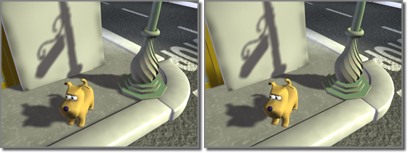Map bias moves the shadow toward or away from the shadow-casting object (or objects).

On the right, increased map bias makes the dog appear to float.
For ray-traced shadows, the control is labeled Ray Bias; for shadow-mapped shadows, it is labeled simply Bias.
By default, this value is 1.0 world coordinate unit. Increasing the bias moves the shadow away from the object, and decreasing the bias moves the shadow closer to the object. The Map Bias value can be any positive floating-point number.
For example, if a shadow-casting object intersects another object but its shadow doesn't meet properly at the intersection, the bias is too high. This effect varies with the angle of the spotlight to the object. Extremely shallow spotlight angles usually require higher bias values.
Another purpose of bias is to avoid problems with objects that cast shadows onto themselves. If you see streaks or moiré patterns on the surface of the object, the bias value is too low. If you increase the bias so much that the shadow becomes disconnected from the object, reduce the bias (and for shadow-mapped shadows, also increase the shadow map Size value).